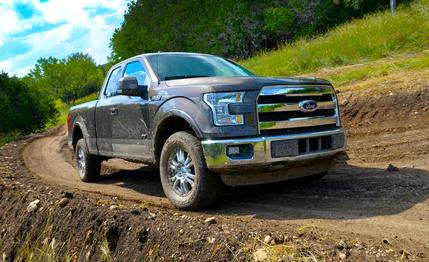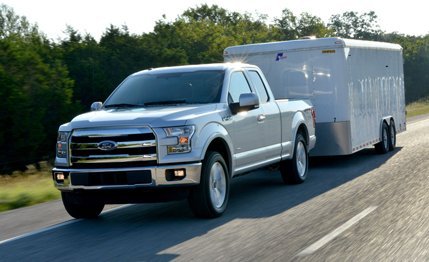
 First Drive Review
First Drive Review
Aluminum cans are all the rage in the craft-brewing industry. Once a symbol of cheap and tasteless beer, cans seal more tightly than do glass bottles, better protect their contents from UV degradation, and reduce the expense and energy that come with shipping a truck full of brews to your local depot. Get past the stigma imprinted by 40-plus years of Miller Lite, and cans are the perfect vessel for high-end beer.
In the light-duty-truck world, beer cans are either all the rage or the ammunition for all of your rage, depending on which automaker's logo your Calvin decal is pissing on. The aluminum-bodied 2015 Ford F-150 brings huge weight savings for America’s bestselling vehicle. You’d think this would be universally accepted as innovation, progress, and a generally good thing. But in the vernacular of a Chevy or Ram loyalist, beer cans take on a condescending connotation, as in “I’d never drive a truck made out of beer cans.” These people prefer their trucks be made from SpaghettiOs cans, apparently.
They don’t take the beer-can analogy lightly at Ford. It’s to the point that F-150 marketing boss Doug Scott needs 13 syllables every time he mentions the lightweight metal. "High-strength, military-grade aluminum alloy" purged as much as 500 pounds from the cab and bed of the new truck. The single significant piece of steel in the body is the laminated firewall, designed to keep unseemly sounds out of the cabin. With more than three times as much high-strength steel as in the outgoing truck, the underlying frame sheds between 60 and 70 pounds. Lighter seats, leaf springs, and lower control arms contribute to a claimed total reduction of up to 700 pounds per truck.


READ MORE: 10 Things You Didn’t Know About the 2015 Ford F-150
We’re always skeptical of manufacturer weight claims, though. When the latest Land Rover Range Rover adopted aluminum construction, its maker claimed a loss of more than 900 pounds. Our scales proved that the diet actually dropped fewer than 400 pounds model-to-model. So our first order of business with the 2015 F-150 was to steer away from the Ford-prescribed drive route and follow the big-rig breadcrumbs to the nearest certified truck scale in Comfort, Texas. Our test subject, a Ford F-150 Platinum crew cab equipped with four-wheel drive and the 3.5-liter EcoBoost V-6, carried a price tag heavier than a truck made of lead: $61,465. Its actual weight, however, came in at 5580 pounds. Our comparative truck, a 2013 Ford F-150 Limited EcoBoost V-6 that we previously tested in Michigan, landed at 6029 pounds. The difference: 449 pounds.
The mathematicians among us will note that 449 isn’t 700. Still, that differential is large enough that we’re taking Ford at its word, because if we’re being honest, we have to point out that we’re comparing well-equipped apples to slightly elongated, fully loaded apples here. Our 2013 test truck wore the standard five-and-a-half-foot bed whereas our 2015 F-150 was equipped with an extra foot of bed length and the commensurate stretched wheelbase. Our reference truck came in Limited trim; the new Platinum packed on the pounds with indulgences like a panoramic glass roof. Identically equipped new and old F-150s might not be 700 pounds apart, but we’re confident that the spread would be more than 600 pounds.
If an aluminum body is controversial, a 2.7-liter V-6 in a full-size truck ranks as blasphemy. (A freebie for those who hate F-150s and love bad analogies: You can buy a 3.0-liter of Stars & Stripes cola at Dollar Tree.) But Ford’s new EcoBoost engine is packed with technology and punches above its displacement with output ratings of 325 horsepower and 375 lb-ft of torque. It uses twin turbochargers and direct injection like the 3.5-liter EcoBoost engine, augmented with robust hardware such as a compacted-graphite-iron block, cracked main caps, and cylinder heads with integrated, water-cooled exhaust manifolds. (For more, read our deep dive on the engine.) The smallest six-cylinder pulls confidently low in the rev range and offers exceptional refinement in terms of noise, vibration, and power delivery. It’s worth every penny of the $795 premium over the base engine.
It’s a similar story with the 3.5-liter EcoBoost V-6, a carry-over from last year that stands above the V-8 in price and performance. When we hitched 9000 pounds of cargo trailer to the 385-hp 5.0-liter V-8, we missed the 33 additional pound-feet of turbocharged torque from the EcoBoost engine. Not to mention, the boosted V-6 engines emit a convincing eight-cylinder growl that’s tracked into the cabin via software that monitors the engine rpm and the torque demand. What Ford calls “sound enhancement” is quietly included in upper trim levels to amplify the otherwise-quiet 2.7-liter and 3.5-liter EcoBoost engines.


The only engine that we were unable to sample was the F-150’s base engine, the 283-hp naturally aspirated 3.5-liter V-6, which tags in to replace the 3.7-liter six. While it’s essentially a fleet-buyer special, the base engine can now be paired with a four-wheel-drive crew cab, courtesy of the lighter body.
READ MORE: 5 Cool Ways Ford Stripped Weight from the 2015 F-150 Chassis
Ford had some catching up to do in ride quality and rigidity, and this truck delivers. The F-150 exhibits a smooth ride and a structure that calms—but doesn’t eliminate—the secondary ride motions that ripple through a truck when you run over choppy pavement. It displays better body control than the Ram 1500 and offers a cabin that’s about as quiet as that of the Silverado. The steering is a touch on the light side yet accurate and responsive. Only the brake pedal, being touchy and failing to deliver any feedback, needs further improvement.
Ford says to expect fuel-economy gains of 5 to 20 percent over last year’s figures thanks to the aluminum diet. For those who use their pickups for work, though, the real advantage of an aluminum body is that weight taken out of the truck can be used to raise towing and payload capacities. The F-150 now claims the highest maximum ratings of any light-duty truck in the country, at 12,200 pounds of towing and 3300 pounds of in-bed capability. Two regular-cab, base-engine models, however, do see decreases in their load-carrying abilities, one by as much as 200 pounds.